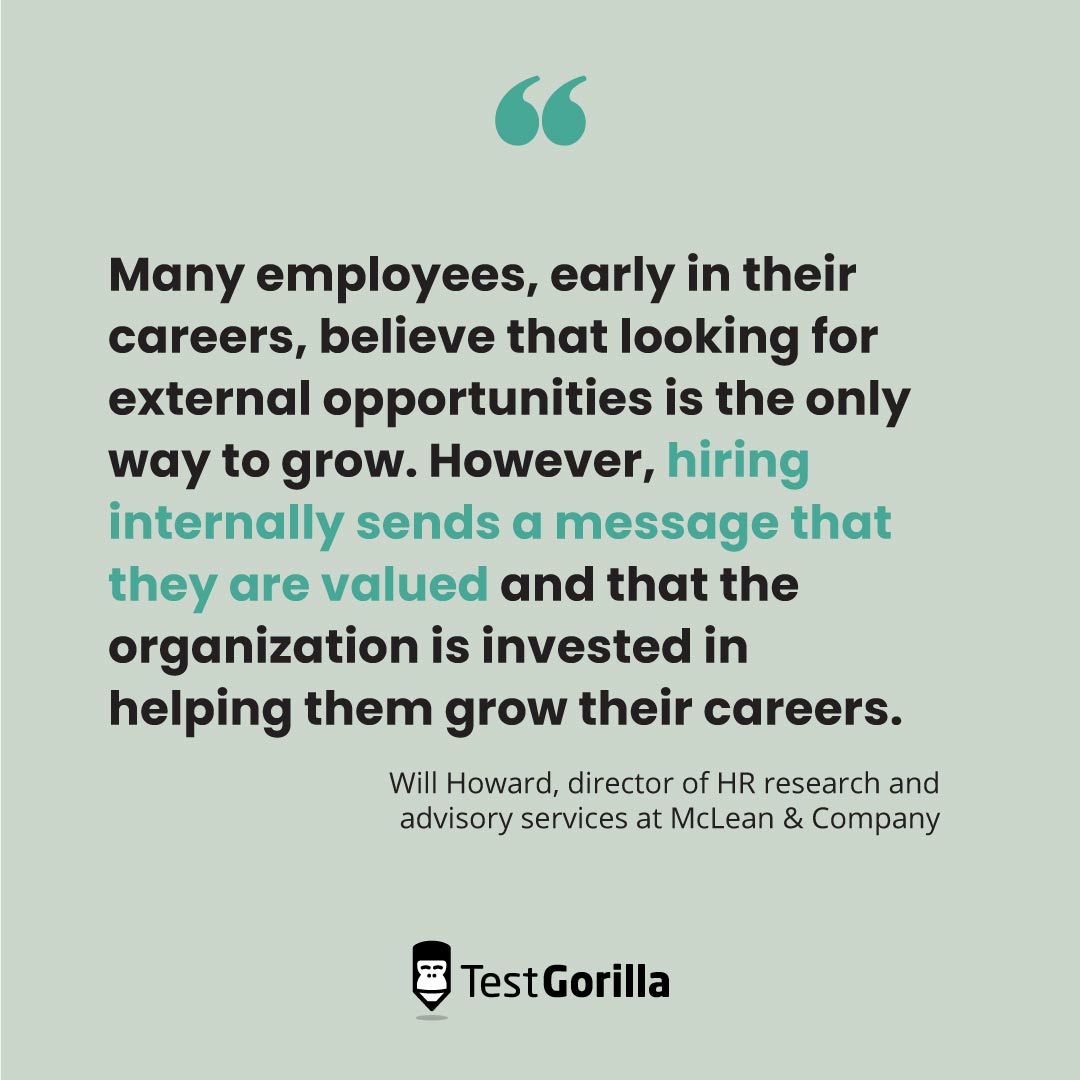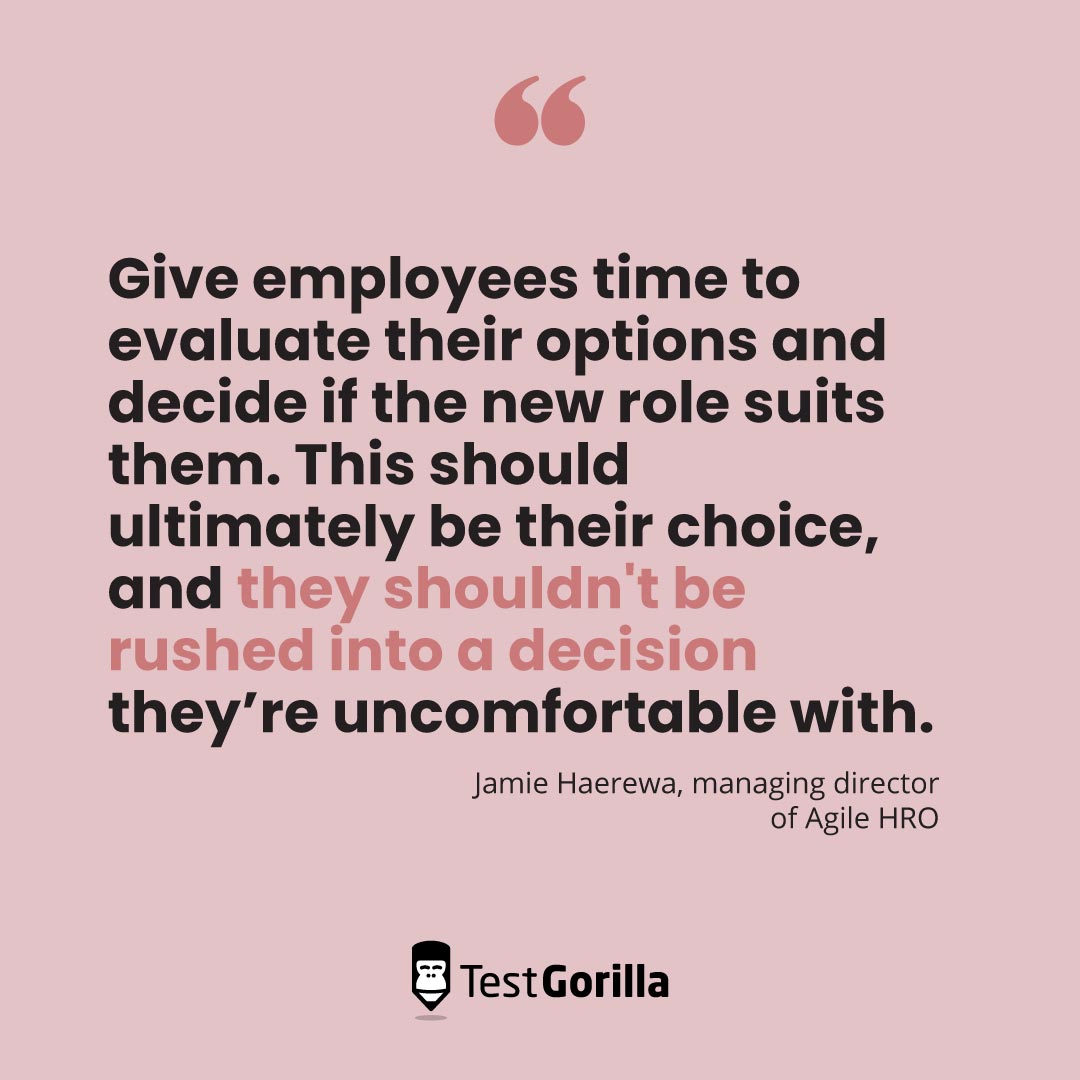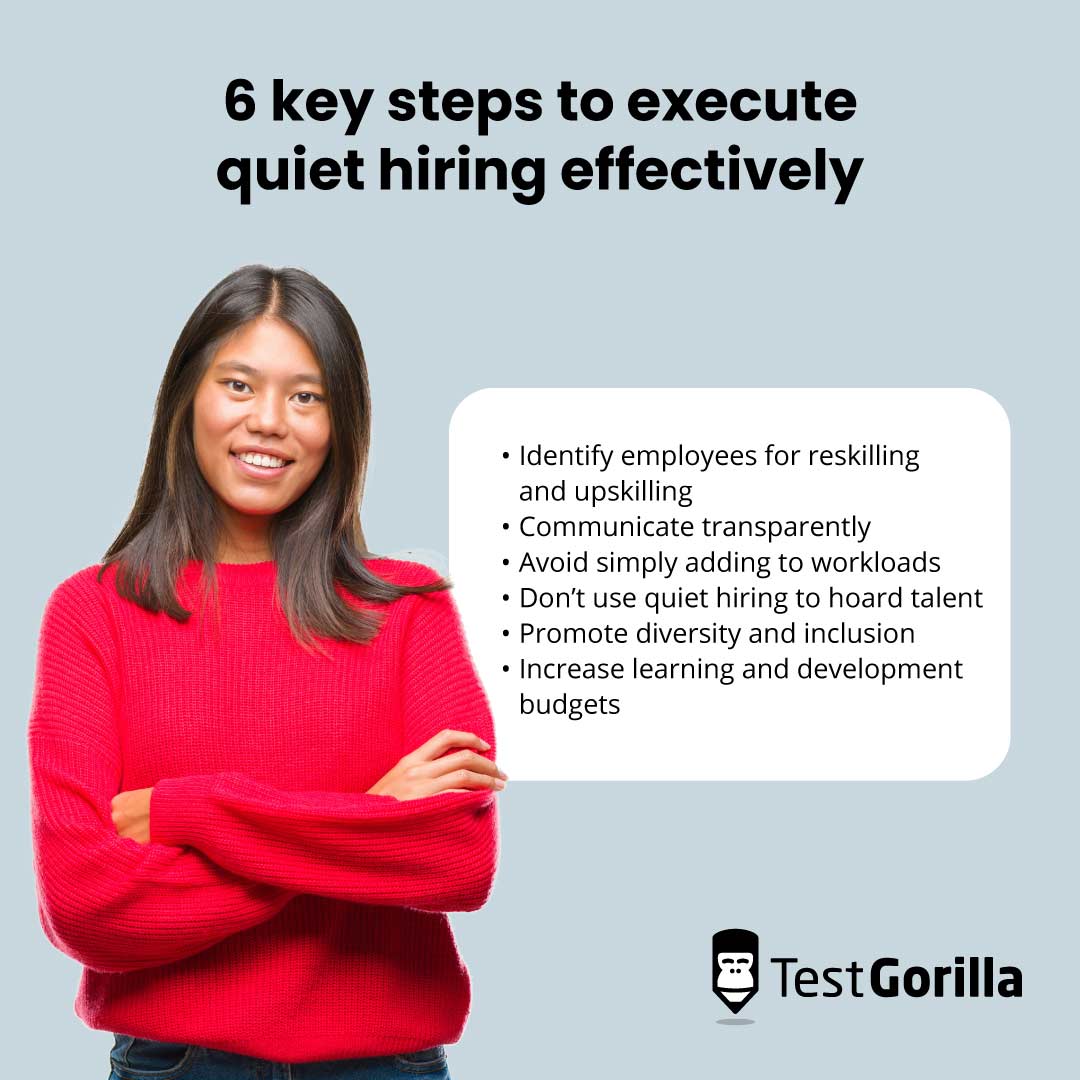Amid global economic downturn, unemployment rates have hit historic highs in many parts of the world.[1] Around 1,000 tech companies have announced layoffs since the start of 2023, including leading brands like Accenture, Amazon, Meta, and Salesforce.[2]
Reasons for layoffs include over-hiring during the Covid-19 pandemic, a potential recession, and pressure from investors to scale back expenses and protect profit margins.
Yet many companies continue to hire, still riding out the ripples of “The Great Resignation” – when people quit their jobs during the pandemic in search of better opportunities. HR managers across the board remain locked in a war for talent as occupational mobility increases thanks to the shift to remote working.
This means employees aren’t afraid to explore other job opportunities if their current role doesn’t live up to their expectations.
These pressures are pushing hiring managers to look internally rather than externally for talent — a practice known as “quiet hiring.” Eight out of 10 workers have been “quiet hired,” and the trend continues to grow.[3]
In this article, we’ll show how quiet hiring can help you fill roles quickly and cost-effectively, and benefit your employees by boosting retention and productivity.
Table of contents
✅ Want to build a solid talent pipeline? Download the 2022 State of Skills-based Hiring report
What is quiet hiring?
Quiet hiring is the practice of strategically filling positions within an organization using current employees. This can be done through internal promotions or lateral moves between departments or roles.
The practice of quiet hiring isn’t new, but it’s becoming increasingly popular as companies face a tight labor market and the need to hire more diverse and engaged teams to stay competitive and agile.
The term is used differently in different contexts: Some use it to mean quickly filling roles in response to an urgent need. For example, if an employee suddenly quits or a new position opens up, a current employee can swiftly fill the gap.
Take the case of Qantas, the Australian airline company. In August 2022, the company was grappling with labor shortages amid the post-pandemic surge in air travel. To fill the gap, nearly 100 senior managers were asked to swap their office jobs for ground staff roles.
To others, quiet hiring is just internal mobility by another name.
Either way, the goal is to reduce time-to-fill, optimize your recruitment budget, and create career pathways for employees.
What are the benefits of quiet hiring?
Quiet hiring works best when you can find employees with skills “adjacent” to the ones you need to fill a gap and then invest in training them.
Tapping into and developing these skill sets can help you win the talent war and benefit you and your employees by:
Reduced time-to-fill: You already know the internal candidates, so you may be able to fast-track them or skip certain parts of the hiring process, like background checks.
Reduced recruitment costs: The Society for Human Resource Management (SHRM) says it can cost more than $4,000 to fill each open role.[4] Quiet hiring helps reduce those costs and maximize ROI by filling roles from within and cutting out parts of the hiring process. Current employees may be less of a flight risk than external candidates, and so more likely to stay longer.
Cross-functional skills development: Sixty-three percent of employees believe quiet hiring helps them learn new skills.[5] When employees are assigned roles outside their original departments, they have an opportunity for cross-functional collaboration. This helps develop cross-functional knowledge and a well-rounded skill set.
Better alignment with job requirements: Since quiet hiring often involves direct outreach to potential candidates, you’re more likely to approach those with specific skills and experience required for the job. They may also be a better fit for the role than those who apply through traditional job postings.
Can benefit diversity: Quiet hiring can benefit diversity by creating opportunities to move people from underrepresented groups up to senior positions. Moving someone internally may also create an opportunity to hire a diverse external candidate to fill their former position.
Increased job satisfaction: Internal candidates can take on roles that challenge them, open up new opportunities, and accelerate their careers, which boosts engagement and morale. They also have a wealth of institutional knowledge and internal networks to help them succeed quickly, which can be highly gratifying.
“Many employees, early in their careers, believe that looking for external opportunities is the only way to grow. However, hiring internally sends a message that they are valued and that the organization is invested in helping them grow their careers.” Will Howard, director of HR research and advisory services at McLean & Company
How to apply quiet hiring in your organization
When implementing quiet hiring in your organization, transparency, communication, and preparation are key.
We reached out to experts in the HR space to get their perspectives on how to execute quiet hiring effectively and identified six key steps:
Identify employees for reskilling and upskilling
Communicate transparently
Avoid simply adding to workloads
Don’t use quiet hiring to hoard talent
Promote diversity and inclusion
Increase learning and development budgets
Let’s take a look at those in detail.
1. Identify employees for reskilling and upskilling
The best way to combat the Great Resignation is to address the causes of the Great Discontent. Those include a lack of purpose in work, poor work-life balance, limited career growth opportunities, or a toxic work environment.
Many employees say the opportunity to grow and learn is the number one factor in job satisfaction and a positive work environment.[6] This means companies that prioritize professional development and offer opportunities for their employees to learn new skills and advance in their careers stand a better chance of attracting and retaining top talent.
To do this, use talent assessments to identify employees for upskilling and reskilling before moving people to a new role. Developing these skills through training, support, and mentoring will help quiet hiring go smoothly and be a success.
In our 2022 State of Skills-based Hiring report, we found that 91.2% of companies experienced increased employee retention when they recruited candidates based on skills rather than background, qualifications, or experience.
You should also monitor employee performance reviews, key performance indicators (KPI) completion, and skills assessment tests to identify employees who are ready for more responsibility.
When you encourage and equip your employees to learn new skills, you can save up to $60,000 per employee.[6] This is because it can be much more expensive to recruit and train new employees than to develop the skills of existing ones.
“Depending on the conclusions, there will be times when upskilling an internal candidate will make more sense than bringing in someone new,” says Bogdan Apostol, co-founder & chief executive officer of Nestor, adding, “By having a clear picture of both actual and desired proficiency levels, companies can address existing competency gaps. This allows managers to create and assign employee development goals and initiate learning, mentorship programs, or additional training as needed.”
2. Communicate transparently
Viktoria Potapenko, a recruiter at Jooble, warns that quiet hiring isn’t always perceived positively by employees.
When employees see internal mobility happening, they can assume that it means the company isn’t in good financial shape or that they’re being kept out of the loop on important changes, which can create uncertainty and demotivation.
Of course, this may be the case in times of economic uncertainties arising from a recession, changes in industry trends, or technological disruptions that can impact the demand for certain skills or jobs and, therefore, job security.
From the employee’s perspective, risk aversion, fear of failure, and lack of initiative may also prevent interest in joining a new department. However, since nearly 16% of employees would continue in a new role with their current employer if the move is temporary, they may be willing to take a temporary position within the same company rather than leave altogether in an uncertain job market.
This is when open, honest communication can help reassure them and manage their expectations.
Will advises, “Share job postings internally first before going external. This gives internal candidates a headstart on the application process and communicates to the organization that internal candidates are a priority.”
According to a 2023 report by Cornerstone People Research Lab, 73% of employees want to learn about career opportunities with the company.[7] The prospect of occupational mobility helps attract and retain employees, allowing them to grow and develop within their organization.
3. Avoid simply adding to workloads
According to a survey, nearly 15% of employees say that their current role is not the one they signed up for, which can be a good thing or a bad thing depending on the reasons.
When assigning people to new roles, you should balance employee workloads with C-suite expectations. Overloading employees with too much work can lead to burnout and fatigue, which can have negative impacts on their health and job satisfaction.
For this reason, quiet hiring shouldn’t be about adding to workloads to meet your goals; it should also be about optimizing employee skills and strengths. This can lead to higher levels of employee engagement and motivation, which in turn may result in higher productivity and better business outcomes.
Jamie Haerewa, managing director of Agile HRO recommends “considering the resources you can use to lighten their workload. If your team is already stretched thin and adding a new role internally would be a significant burden, looking for external candidates with the necessary skills and experience may be more practical.”
“Give employees time to evaluate their options and decide if the new role suits them. This should ultimately be their choice, and they shouldn’t be rushed into a decision they’re uncomfortable with.”
Jamie Haerewa, managing director of Agile HRO
Compensation is another factor. When changing employees’ roles, you should consider updating their compensation structure to reflect their new responsibilities. That way, they don’t feel like the changes are unfair, and instead feel like they’re being rewarded for the extra work.
4. Don’t use quiet hiring to hoard talent
Talent hoarding occurs when leaders hold onto valuable employees without allowing them to take on new challenges or advance in their careers.
Talent-hoarding managers can be a huge roadblock to internal mobility. For example, if there’s a perception of poaching employees from other teams, it can result in hiring managers dismissing internal candidates to avoid conflict. Ultimately, this could lead to employees being more likely to leave the organization.
At the end of the day, internal mobility is a two-way street. Employers should create an environment that encourages employees to take the initiative and apply for new roles within the company. Employees, for their part, should be willing to take risks and adopt a growth mindset if called on to move laterally or vertically for the good of the company. Leaders, for theirs, need to prioritize overall business goals over departmental ones.
It’s all about identifying the right people and putting them in roles that increase their value and loyalty to the company instead of creating barriers to growth – both for employees and the company.
5. Promote diversity and inclusion
When employees feel that they’re part of a diverse and inclusive workplace, they’re more likely to feel valued and respected, leading to higher levels of job satisfaction and lower turnover rates.
Viktoria says: “It’s a potential risk that quiet hiring can lead to a less diverse workforce because opportunities are not opened up to external candidates. But companies should consider workforce diversity when planning for quiet hiring. Evaluate candidates for new roles in the company on qualifications, skills, and potential, and not on years of experience or higher education.”
Again, bias-free talent assessments can help you identify the right internal candidates based on skills and merit rather than factors like race, age, etc.
Will adds that measurement is also key for promotions and internal moves without bias. He advises companies to consider workforce diversity when planning for quiet hiring by periodically evaluating diversity metrics like demographics across organization levels, retention across employee groups, and employee turnover, and adjusting quiet hiring practices accordingly.
6. Increase learning and development budgets
If you’ll be moving people around, prepare the groundwork by providing training and development programs and offering mentorship and coaching to employees interested in advancing their careers.
You should also establish clear pathways for internal mobility, including policies and procedures for applying for and moving into new roles. This can help to create a more transparent and equitable process for employees to explore new opportunities within the company. Nearly 76% of employees say they’re more likely to stay with a company that offers continuous training.[8]
Learning and development (L&D) initiatives serve two purposes:
To reskill and upskill current employees to fill business gaps
To attract, retain, and reward employees who want to develop their skills and knowledge
One company that understands the importance of L&D is Amazon. In September 2021, the e-commerce giant announced its Upskilling 2025 pledge, which allocated nearly $1.2 billion to education and skills training programs for some 300,000 employees until 2025.
These training programs cater to employees across Amazon’s corporate offices, tech hubs, fulfillment centers, retail stores, and transportation networks, creating a win-win situation for the company and the employees.
If you can’t match Amazon’s investment, you can allocate resources to L&D programs in line with your budget. For example, you could invest in a learning management system, online courses, industry certifications, and conferences.
Remember, though, that certifications aren’t always the best proof of skill, so consider how a skills-based test or assessment can help you select the right employees for an internal move.
Quiet hiring: One way to adapt and thrive in a changing labor market
While layoffs and recessions still dominate the headlines, many labor markets face talent shortages with increasing attrition rates. With this in mind, many HR managers are looking internally to fill open roles.
Quiet hiring isn’t new, but it’s becoming increasingly popular as companies seek to remain agile and competitive in today’s rapidly changing business environment. Done right, it can help streamline recruitment, maximize ROI and reduce costs, and increase employee loyalty and satisfaction.
Here’s a quick recap of how you can implement quiet hiring:
Use skill-based tests to identify employees for upskilling and reskilling
Communicate transparently
Avoid simply adding to workloads
Don’t use quiet hiring to hoard talent; use it to develop talent instead
Promote diversity and inclusion
Invest in learning and development programs and career guidelines
When you implement these best practices, you can build a fairer, more diverse workplace with productive employees who stay longer.
Build a solid talent pipeline – internally or externally.Talent assessments let you find the perfect candidate for the job and build a winning team. Download the 2022 State of Skills-based Hiring report to learn more.
Sources
World Employment and Social Outlook: Trends 2023. January 2023. https://www.ilo.org/wcmsp5/groups/public/—dgreports/—inst/documents/publication/wcms_865387.pdf
Companies that announced Major Layoffs and Hiring Freezes. April 2023. https://intellizence.com/insights/layoff-downsizing/major-companies-that-announced-mass-layoffs/
Poll Results: Quiet Hiring (Results and findings from recent research on the future of work and the evolving jobs market). January 2023. https://learnmore.monster.com/poll-results-quiet-hiring
Bika, N. ‘Recruiting costs FAQ: Budget and cost per hire,’ Workable: Resources for Employers, available at: https://resources.workable.com/tutorial/faq-recruitment-budget-metrics
Employee Well-Being Report. May 2021. https://www.glintinc.com/wp-content/uploads/2021/05/Glint-May-2021-Employee-Well-Being-Report.pdf
Financial Services Skills Commission (FSSC) and PwC: A business case for financial services organizations report. January 2022. https://wp.financialservicesskills.org/wp-content/uploads/2022/01/Reskilling-A-business-case-FINAL-EMBARGOED.pdf
Cornerstone People Research Lab and Lighthouse Research & Advisory: 2023 talent mobility study. https://www.cornerstoneondemand.com/resources/article/2023-talent-mobility-study/
SHRM 2022 Workplace Learning & Development Trends. https://www.shrm.org/hr-today/trends-and-forecasting/research-and-surveys/Documents/2022%20Workplace%20Learning%20and%20Development%20Trends%20Report.pdf
Related posts
Hire the best candidates with TestGorilla
Create pre-employment assessments in minutes to screen candidates, save time, and hire the best talent.
Latest posts
The best advice in pre-employment testing, in your inbox.
No spam. Unsubscribe at any time.

Hire the best. No bias. No stress.
Our screening tests identify the best candidates and make your hiring decisions faster, easier, and bias-free.
Free resources
This checklist covers key features you should look for when choosing a skills testing platform
This resource will help you develop an onboarding checklist for new hires.
How to assess your candidates' attention to detail.
Learn how to get human resources certified through HRCI or SHRM.
Learn how you can improve the level of talent at your company.
Learn how CapitalT reduced hiring bias with online skills assessments.
Learn how to make the resume process more efficient and more effective.
Improve your hiring strategy with these 7 critical recruitment metrics.
Learn how Sukhi decreased time spent reviewing resumes by 83%!
Hire more efficiently with these hacks that 99% of recruiters aren't using.
Make a business case for diversity and inclusion initiatives with this data.






















